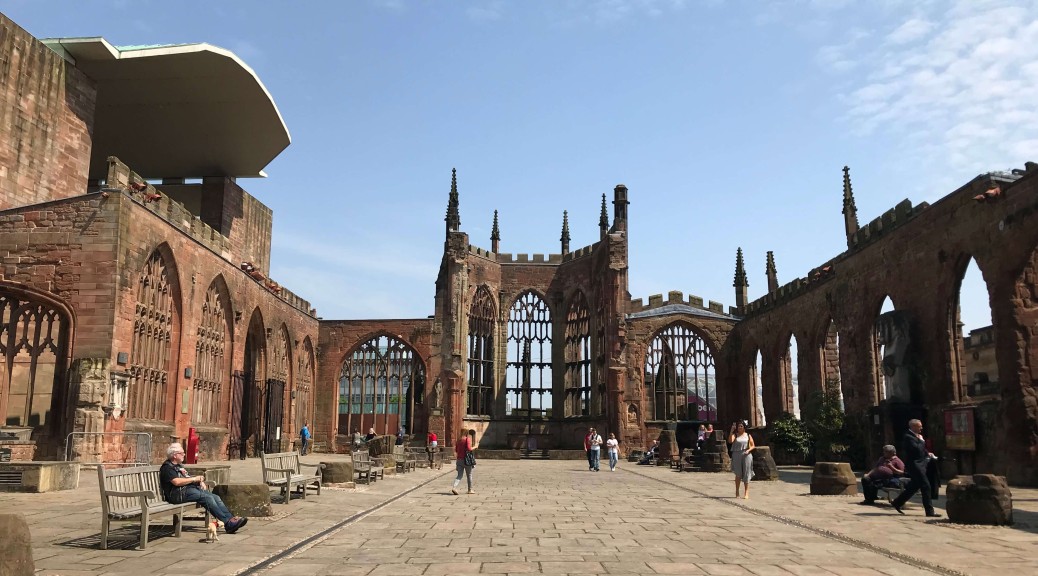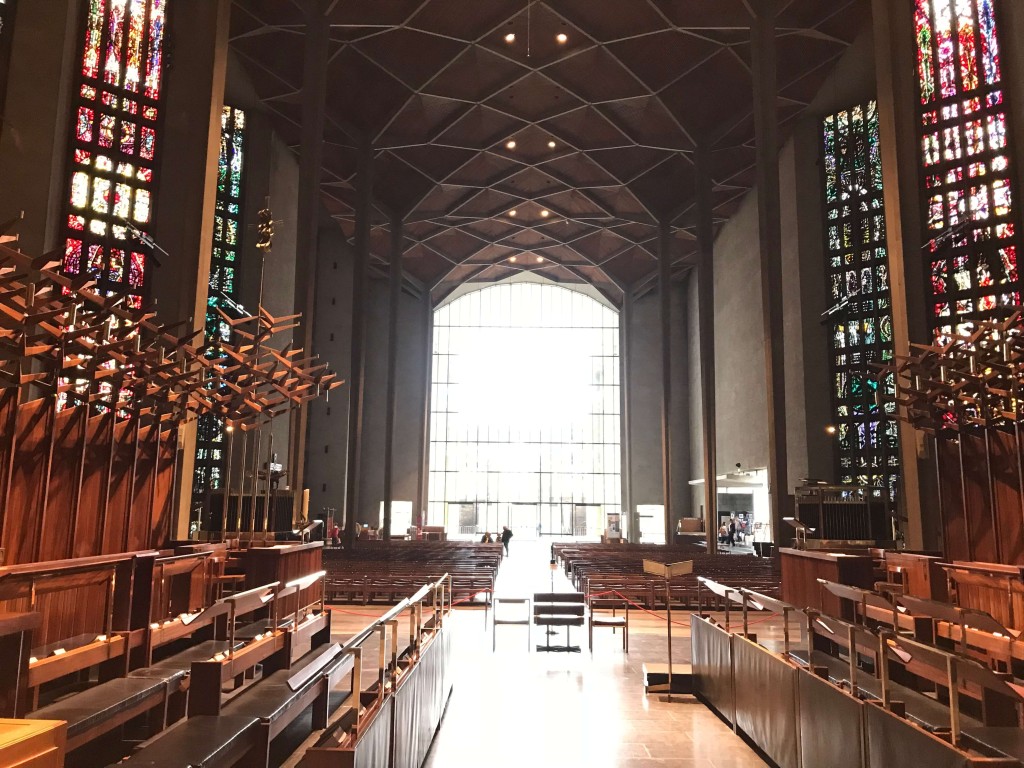A sermon delivered at St. Elizabeth’s Episcopal Church in Roanoke, Virginia, on Good Friday, 2019 (April 19).
“Destroy this temple, and in three days I will raise it up.”
The first time I visited London, England, nearly 50 years had passed since the end of World War II, but you could still see the scars. One of our teachers showed us small, ragged pockmarks in the sides of great lion sculptures along the Thames, where shell fragments had struck them. The Imperial War Museum and other sites narrate the violence of the battles and the violence of the Holocaust. German bombs fell on the city for six years, killing 30,000 people and destroying 70,000 buildings. The beloved dome of St. Paul’s Cathedral survived because teams of people remained at the church round the clock, chasing after and disposing of anything that fell on its roof. And even that St. Paul’s, if you go a few more centuries back in history, was reborn after its own destruction – the previous St. Paul’s, a massive Gothic structure, was destroyed in the Great Fire of 1666 – the one we know was designed by the architect Christopher Wren, who re-visioned not only the churches but the very layout of London itself in the years following that great disaster.
I remember that same year visiting another London church that didn’t survive the bombing of World War II – only its walls and I think a tower were left. But half a century later, those walls and that tower still stood in the middle of a modern, international city, and within those walls is planted a garden, with flower beds marking where the pews and altar used to be.
Last summer, I visited Coventry Cathedral, a few hours’ travel outside London by train. It, too, was nearly destroyed by an overnight bombing in World War II. In the morning, one of the cathedral staff climbed the tower to survey the damage and saw that two beams had fallen in the shape of a cross. He bound them together, and they still are there in Coventry, preserved. The wooden rooftop had burned, had fallen in, and with it, medieval nails. The church took those nails and made more crosses out of them, and sent them to prime ministers and politicians and priests. After the war was over, Coventry reached out to communities in Germany that had also been bombed, and they began to help each other rebuild. Coventry rebuilt its cathedral, preserving the old ruins and adding a beautiful new sanctuary and an ecumenical chapel, with art and stained glass. You can stand at the top of the ruined steps and see through the windows, with their etchings of angels, all the way to the new altar, with Jesus’ face over it. The Community of the Cross of Nails grew out of that cathedral’s destruction, an organization focused on reconciliation that works to heal conflicts around the world.
Destroy this temple, and in three days I will raise it up.
Words from the Gospel of John, chapter 2.
Early this week we all stared, horrified, at television screens or social media as we saw images of the Cathedral of Notre Dame burning. We watched the great spire ignite, its geometry illuminated by flame, and then collapse. We wondered if the rose windows, the pipe organ, the ancient relics had survived. We listened to Parisians gather outside the church and sing hymns as night fell. I wept over my Twitter feed.
Of all times, Holy Week. Of all cathedrals, Notre Dame. A temple, destroyed, or at least partly.
We weep over these sacred spaces. We all have been weeping this week, even those of us who aren’t Catholic or even Christian. We weep for the history lost, for the humanity that has lived and prayed and sung and communed and celebrated in those walls, for the music and art, love and wisdom those spaces inspired. They are sacred, beloved not simply because of the materials that make them up, the wood and stone and glass, but more so because of the life they have held and continue to hold. We cannot imagine them gone, and if they are consumed by fire, we cannot fathom the loss.
This week, watching the cathedral burn, and then learning, bit by bit, what had been saved, I can’t help thinking of these other churches, just across the channel. They were not consumed forever. What threatened to destroy them – fire, and the world war that ignited those fires – instead transformed them, into gardens, into bridges, into communities of human beings connected by love.
So imagine that terrible Good Friday, 2,000 years ago, the scene of a public execution. Three men are on crosses and crowds are watching them die, witnessing an end of life that should not have happened this way, with this pain, with spectators. No glorious death in battle, no peaceful death in old age. And that is the death Jesus endured, after a last meal with his friends and followers, and an agonized night in the garden, praying for strength. “’Am I not to drink the cup that the Father has given me?’”
Jesus, in choosing to be fully human, accepted one of the worst human deaths there could be, one without comfort, without compassion, without dignity.
This, Good Friday, is the most human of the holy days. Jesus’ very human death, witnessed by very human grief and fear – Mary, Mary’s sister, Mary Magdalene, and one or more of the apostles. His body collapsed, gave out – like the collapse of a cathedral – but that collapse was just the materials. What made him beloved, sacred, was the love and wisdom his architecture held. His mother, watching him die, mourned every prayer, every laugh, every embrace, every argument; she mourned the infant, the boy, the man. His apostles likely looked on with the same disbelief we felt watching Notre Dame burn – he was so strong, so present. He was supposed to be forever. What happened?
“We heard him say, ‘I will destroy this temple that is made with hands, and in three days I will build another, not made with hands.’”
The Gospel of Mark, chapter 14.
Here is what we know, which Mary never doubted, I think, though his apostles must have on this day of days, when it seemed like the power of Rome had had the final say, when their Messiah shunned the sword for the cross.
Jesus’ death was not forever. He was not destroyed. Instead, Jesus and the world were transformed.
Jesus’ death and resurrection are the arms of love reaching beyond the destruction of war. They are the love that speaks from the cross to make sure his mother will have a home, to comfort a dying criminal. They are the good news spoken to the quietly faithful at the empty tomb, they are the companion on the road to Emmaus, the flames of the Pentecost to come. Jesus’ death and resurrection are the inspiration behind the music and the wisdom and the rose windows and the soaring spires of cathedrals in ages to come – the architecture, and the joy and love and communion and celebration their architecture holds. Jesus’ death and resurrection are a garden planted in brokenness, giving birth to goodness.
Right now, we wait in darkness and everything seems lost. But morning will come.
Images: Coventry Cathedral, summer 2018 (ruins and rebuilt); photos by Cara Ellen Modisett

